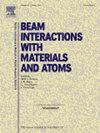Stopping cross section measurement for He+ in SiO2 with two angles of incidence in medium energy ion scattering spectrometry
IF 1.4
3区 物理与天体物理
Q3 INSTRUMENTS & INSTRUMENTATION
Nuclear Instruments & Methods in Physics Research Section B-beam Interactions With Materials and Atoms
Pub Date : 2025-02-01
DOI:10.1016/j.nimb.2024.165598
引用次数: 0
Abstract
Ion-scattering spectrometry is a technique used to obtain compositional depth profiles by bombarding a sample with accelerated ions and analyzing the scattered particle energy. To obtain the depth profile from the ion-scattering spectra, simulations are usually performed using kinematic factors, scattering cross sections, stopping cross sections, and straggling, and accurate values are required for accurate analysis. This study proposes a method for obtaining stopping cross sections for pre- and post-collision energies by measuring the ion scattering spectra at the same scattering angle and at two different incident angles. Using this method, the stopping cross sections for He+ in SiO2 below 100 keV were measured.
中能离子散射光谱法中SiO2中He+的双入射角停止截面测量
离子散射光谱法是一种通过用加速离子轰击样品并分析散射粒子能量来获得成分深度剖面的技术。为了从离子散射光谱中获得深度剖面,通常使用运动学因素、散射截面、停止截面和散列进行模拟,并且需要精确的数值才能进行准确的分析。本文提出了一种通过测量离子在相同散射角和两个不同入射角下的散射光谱来获得碰撞前后能量的停止截面的方法。用该方法测量了He+在低于100 keV的SiO2中的停止截面。
本文章由计算机程序翻译,如有差异,请以英文原文为准。
求助全文
约1分钟内获得全文
求助全文
来源期刊
CiteScore
2.80
自引率
7.70%
发文量
231
审稿时长
1.9 months
期刊介绍:
Section B of Nuclear Instruments and Methods in Physics Research covers all aspects of the interaction of energetic beams with atoms, molecules and aggregate forms of matter. This includes ion beam analysis and ion beam modification of materials as well as basic data of importance for these studies. Topics of general interest include: atomic collisions in solids, particle channelling, all aspects of collision cascades, the modification of materials by energetic beams, ion implantation, irradiation - induced changes in materials, the physics and chemistry of beam interactions and the analysis of materials by all forms of energetic radiation. Modification by ion, laser and electron beams for the study of electronic materials, metals, ceramics, insulators, polymers and other important and new materials systems are included. Related studies, such as the application of ion beam analysis to biological, archaeological and geological samples as well as applications to solve problems in planetary science are also welcome. Energetic beams of interest include atomic and molecular ions, neutrons, positrons and muons, plasmas directed at surfaces, electron and photon beams, including laser treated surfaces and studies of solids by photon radiation from rotating anodes, synchrotrons, etc. In addition, the interaction between various forms of radiation and radiation-induced deposition processes are relevant.

 求助内容:
求助内容: 应助结果提醒方式:
应助结果提醒方式:


